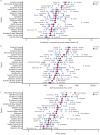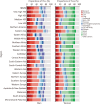Global patterns and trends in cancer-related premature death and their impact on life expectancy across 185 countries: a population-based analysis
- PMID: 40903768
- PMCID: PMC12406598
- DOI: 10.1186/s40779-025-00645-9
Global patterns and trends in cancer-related premature death and their impact on life expectancy across 185 countries: a population-based analysis
Abstract
Background: The level of premature deaths (deaths among those aged 30-69 years) caused by cancer is an important indicator of evaluating the level of cancer prevention and control. However, the current burden and temporal trends in cancer-related premature deaths, and their impact on life expectancy at the global, regional, and national levels are not clear.
Methods: Cancer mortality data for 185 countries were obtained from the GLOBOCAN 2022 database. High-quality cancer mortality data and national population statistics for 47 countries were extracted from the United Nations and national cancer registry databases, covering the period 2003-2022. Countries were classified based on the human development index (HDI). The death probability, the year of life lost (YLL), and the potential gain in life expectancy (PGLE) attributable to premature deaths from site-specific and all-cancers combined were calculated.
Results: Globally, the probability of premature cancer deaths was 6.49% (95% UI 6.49-6.50). The YLLs caused by cancer-related premature death were 163.86 million (95% UI 163.70-164.03), constituting 65.58% of the total cancer-related YLLs. The PGLEs were 1.16 years (95% UI 1.16-1.16). The premature death probability increased with higher HDI levels in men, but decreased in women. Cancer-related premature deaths as a proportion of total cancer deaths varied from 18.31% (95% UI 18.20-18.43) in Japan to 84.44% (95% UI 76.10-91.16) in São Tomé and Príncipe. Lung cancer was the leading cause of cancer-related premature deaths in men, and breast cancer ranked first in women. By eradicating premature deaths attributable to lung, liver, colorectal, and stomach cancer in men, and to breast, cervical, and lung cancer in women, 0.55 years (95% UI 0.55-0.55) and 0.49 years (95% UI 0.49-0.49) of PGLEs could be achieved, accounting for 48.67% and 42.24% of the total PGLEs, respectively. Cancer-related premature deaths decreased significantly in 38 countries during 2003-2022 (P < 0.05). The probability of premature cancer-related deaths decreased by more than 15.50% from 2015 to 2022 in 16 countries.
Conclusions: Cancer-related premature deaths declined in many countries, with 16 of them having achieved the expected reduction by 2022. The current burden of cancer-related premature deaths is profound but varies around the world. Eliminating premature deaths from major cancer types could substantially increase life expectancy, underscoring the importance of prevention and treatment efforts for these cancers.
Keywords: Cancer; Death probability; Potential gain in life expectancy (PGLE); Premature death; Year of life lost (YLL).
© 2025. The Author(s).
Conflict of interest statement
Declarations. Ethics approval and consent to participate: This study does not involve personal or medical information for any identifiable living individual. The Ethical Committee of the National Cancer Center/Cancer Hospital, Chinese Academy of Medical Sciences, and Peking Union Medical College waived the need for ethical approval or informed consent for this study. Consent for publication: Not applicable. Competing interests: The authors declare that they have no conflict of interest.
Figures




References
-
- World Health Organization. Premature deaths due to noncommunicable diseases (NCD) as a proportion of all NCD deaths. https://www.who.int/data/gho/data/indicators/indicator-details/GHO/ncd-d...). Accessed 2 January, 2024.
-
- Quiambao A, Malekpour MR, Golestani A, Heidari-Foroozan M, Ghamari SH, Abbasi-Kangevari M, et al. World health Organization’s guidance for tracking non-communicable diseases towards sustainable development goals 3.4: an initiative for facility-based monitoring. EClinicalMedicine. 2025;85:103304. - PMC - PubMed
-
- GBD 2021 Diseases and Injuries Collaborators. Global incidence, prevalence, years lived with disability (YLDs), disability-adjusted life-years (DALYs), and healthy life expectancy (HALE) for 371 diseases and injuries in 204 countries and territories and 811 subnational locations, 1990–2021: a systematic analysis for the Global Burden of Disease Study 2021. Lancet. 2024;403(10440):2133–61. - PMC - PubMed
-
- Bray F, Laversanne M, Weiderpass E, Soerjomataram I. The ever-increasing importance of cancer as a leading cause of premature death worldwide. Cancer. 2021;127(16):3029–30. - PubMed
MeSH terms
Grants and funding
LinkOut - more resources
Full Text Sources
Medical

